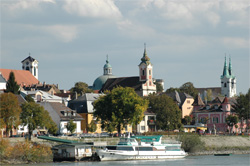Vác
Concert venues:
Dominican Church (22 Március 15. Square [Main Square])
Piarist Church (Szentháromság Square)

Vác
One of the most attractive Hungarian Baroque cities boasts a past dating back to the Bronze Age. It has been a centre of Catholic faith and a diocesan town for centuries.
The city scape is defined by the cathedral. The foundation of the diocese of Vác is unanimously attributed by historians to the first Hungarian king, Saint Stephen I. The completion of the bishop’s cathedral is also associated with King Géza I and, according to this monarch’s wishes he was burried here. The interior decoration of the cathedral dates from the time of King Saint Ladislaus (László).
The present, late baroque cathedral stands next to the episcopal palace together with the canon palace on the Konstantin Square, which is the ecclesialistical centre of the town.
The historic central area of Vác developed in the early 18th century when the once segregated German and Hungarian districts began to merge with one another while maintaining the original medieval town plan. Today the city is the cultural and commercial centre of the left bank of the Danube bend and the most visited tourist destination.
Dominican Church (Fehérek temploma)
The vernacular name of the Baroque-style church, “Church of the Whites” (“Fehérek temploma”) refers to the colour of the robes of Dominican friars. Its construction was delayed from 1699 to 1755 due to the Rákóczi Freedom Fight. The Rococo furnishing inside were created between 1760 and 1770.
The single nave Baroque church with its unassuming exterior well blends into the main square’s atmosphere and is contrasted by the interior’s Rococo ornamentation. Of singular significance are burial finds from Baroque times, recently unearthed in the crypt of the church. These finds are exhibited in one of the cellars of the square.
Piarist Church
The church of the Piarists, consecrated in honour of Saint Anne, was built between 1725 and 1745. The baroque building was transformed in eclectic style in 1866. The statue of Saint Joseph Calasanctius, founder of the order, can be seen in the alcove above the façade balcony. The high altar and the side altars, the pulpit, the sacristy credens and the wooden crucifix were made in the second half of the 18th century. The most valuable piece of the church is the venice mirror tabernacle of the high altar was made in 1759.
Source: hungarystartshere.com
